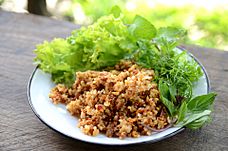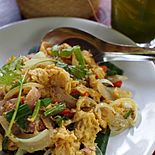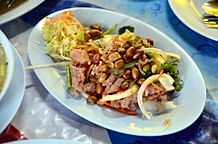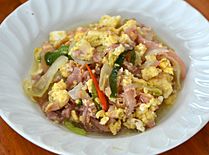Naem facts for kids
|
Naem khluk ("mixed naem") is a Thai salad prepared with naem. At bottom is a close-up view of the same dish.
|
|||||||
| Type | Fermented sausage | ||||||
|---|---|---|---|---|---|---|---|
| Place of origin | North Eastern Thailand | ||||||
| Serving temperature | Raw or cooked | ||||||
| Main ingredients | Pork | ||||||
| Ingredients generally used | Minced beef is sometimes used | ||||||
| 185 kcal (775 kJ) | |||||||
|
|||||||
Naem (pronounced "nem") is a special kind of pork sausage from Thailand. It's a fermented food, which means it's made using a process that gives it a unique sour taste. People often eat naem raw once it's ready. This tasty sausage is popular all over Southeast Asia, and you can find it with different flavors, from sour to spicy. Naem is great on its own as a side dish or mixed into other meals.
A 100 grams (3.5 oz) serving of naem has about 185 kilocalories of energy. It also contains a good amount of protein, some fat, and a little bit of carbohydrates. Scientists have found that the natural lactic acid created during fermentation helps stop bad bacteria like Salmonella from growing. Sometimes, naem is even treated with irradiation to make it safer.
Contents
What is Naem?
Naem is a reddish, semi-dry pork sausage that gets its sour taste from lactic acid fermentation. It's made by mixing raw minced pork and pork skin with cooked sticky rice, chili peppers, garlic, sugar, salt, and potassium nitrate. Sometimes, minced beef is also used.
How Naem is Made
After all the ingredients are mixed, the naem is wrapped up. It can be put into banana leaves, special sausage casings, or plastic bags. Then, it's left to ferment for about three to five days. During this time, good bacteria and yeasts grow. They eat the sugar and rice, creating the sour lactic acid that gives naem its special flavor. The salt helps keep the meat from spoiling.
Storing Naem
Naem usually doesn't last very long. It can be kept at room temperature for about a week. If you put it in the refrigerator, it will stay fresh for longer. Making naem can take a lot of time and effort.
How People Enjoy Naem
Naem is often eaten raw after it has finished fermenting. People usually enjoy it with fresh ingredients like shallots, ginger, bird's eye chili peppers, and spring onions.
Naem in Dishes
This sour sausage is also a key ingredient in many delicious dishes. For example, you can find naem fried with eggs or in a dish called Naem phat wun sen sai khai, which includes glass noodles and eggs. It's also a popular side dish or condiment (a sauce or seasoning). Cooking naem changes its flavor quite a bit, making it taste different from when it's raw.
Naem's Popularity in Thailand
In Thailand, naem is known as one of the most popular meat products. It's a traditional fermented meat that many people love.
Different Kinds of Naem
The taste of naem can be different depending on where you are in Thailand:
- Northern and Northeastern Thailand: The naem here is a little bit sour.
- Central Thailand: This naem is quite sour.
- Southern Thailand: Here, naem is usually spicy.
In northern Thailand, a type called Naem mo might be fermented in a special clay pot.
Dishes Made with Naem
Many tasty meals are made using naem. Here are a few examples:
- Naem fried with eggs: A simple and popular dish.
- Naem phat wun sen sai khai: This dish combines naem with glass noodles, eggs, spring onions, and red pepper.
- Nam Khao: This is a salad from Lao cuisine. It uses Lao fermented pork sausage (similar to naem), rice, coconut, peanuts, mint, cilantro, fish sauce, and lemon juice. The naem and rice are shaped into balls, deep-fried, and then broken up and served with the other ingredients.
Some restaurants even create unique dishes, like the "McNaem" from a restaurant in Bangkok. It's a duck egg wrapped in naem, fried, and served with risotto, slaw, shiitake mushrooms, and sea scallops.
There are also many other ways to enjoy sour pork, such as phat phet naem (a spicy stir-fry), tom kha naem (a sour coconut soup), ho mok naem (a steamed curry), and naem priao wan (sweet and sour naem).
- Dishes prepared with naem
Naem's Nutritional Facts
| Nutritional value per 100g | |
|---|---|
| Energy | 774.04 kJ (185.00 kcal) |
|
3.6
|
|
|
9.9 g
|
|
|
Protein
|
20.2 g
|
| †Percentages estimated using US recommendations for adults. | |
A 100 grams (3.5 oz) serving of naem contains about 185 kilocalories. It has 20.2 grams (0.71 oz) of protein, 9.9 grams (0.35 oz) of fat, and 3.6 grams (0.13 oz) of carbohydrates. Research also shows that naem contains vitamins B1 and B2, iron, and phosphorus.
Safety and Quality Checks
Sometimes, naem samples have been found to contain certain bacteria. However, the lactic acid that forms during the fermentation process helps stop the growth of harmful bacteria like Salmonella. Using a special "starter culture" called Lactobacillus curvatus has also been shown to prevent bad bacteria from growing in naem. To make it even safer, naem is sometimes treated with irradiation.
Rules for Bacteria in Thai Sour Pork
Thailand has strict rules about the amount of bacteria allowed in sour pork products like naem. For example, there should be very small amounts of certain bacteria like Escherichia coli O157:H7 or Salmonella. These rules help make sure that naem is safe to eat and that people don't get sick.







